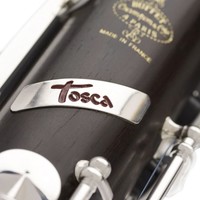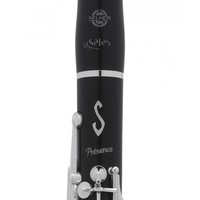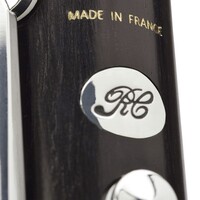A clarinet
The A clarinet is built exactly as the B flat clarinet with a bit more length and sounding a semi-tone deeper. They also use the same mouthpiece. The A clarinet is diligently used in classical music, probably most famously in Mozart's clarinet concerto. Most classical clarinetists own both an A and a B flat clarinet, so they can use the clarinet most suitable for the music they play.
Since the A clarinet is hardly ever used by beginners, almost exclusively professional and semi-professional models are produced. The Buffet models E13, RC, Festival, and Tosca are made in both B flat and A.
Read more on clarinets here!
More on clarinets
Material
Professional clarinets are most often made in the wood type grenadilla and beginner clarinets in the plastic ABS Resin, which has many of the same acoustic qualities as wood. Grenadilla is a hardwood that is related to ebony. Because of overharvesting, this precious type of wood has been certified.
The wood for the grenadilla clarinets is stored and dried before building clarinets from it. Grenadilla is available in different qualities in terms of hardness and uniformity. For the professional clarinets, you use the finest and most well-stored wood and for the school models in grenadilla, you use the less perfect wood which is stored for a shorter time.
Bore
We find the bore on the inside of the clarinet. It is a term for the diameter of the cavity in the body of the clarinet. The bore is conical, ie. it gradually gets bigger down towards the bell.
In addition to the choice of material, there is also a difference in the bore. The bore has a great impact on the sound, the resistance in the instrument, and the musical expression you want to get out of the clarinet.
Pads
The clarinet pad sits inside the key and ensures that the tone holes are closed completely tightly when the key is closed. There is a bunch of different clarinet pads available that use different airtight material as a seal.
- Fish bladder: traditional, inexpensive.
- Leather: lasts a long time.
- Cork: hard material, cheap, good for the smallest tone holes.
- GoreTex: durable and slightly more expensive than the other materials.
Cracks
When you buy a clarinet in grenadilla, it must be played in. This is because wood is a material that is affected by fluctuations in temperature and humidity. If you expose wood to extreme changes, which you do when you play, it can work a little, and if you are unlucky it can crack. If the accident should be out and you get a crack in your clarinet, we can help you to glue the crack so that the clarinet becomes tight again and so you can hardly see the crack. Clarinets in ABS resin usually do not crack.
Maintenance
We recommend that you wipe your instrument after use and store it in the instrument case when you are not playing it. Once a year, you should have your clarinet inspected by an instrument technician, as small leaks and blurs will appear in the mechanics when you play the instrument.
All our clarinets are delivered prepared at our specialist workshop and are sold with a free service check within 6 months from the date of purchase.
-
-
-
Call for price
3311 1047 -
Call for price
3311 1047 -
Call for price
3311 1047 -
Call for price
3311 1047 -
45.000,00
-
Call for price
3311 1047














